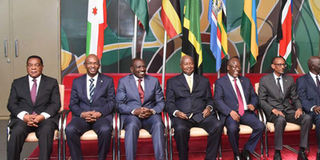EAC at a crossroads after Kenya failure to clinch continental post

EAC Heads of State and Government pose for a group photo during the EAC Summit in Dar es Salaam, Tanzania, on September 12, 2016. President Uhuru Kenyatta launched his chairmanship in 2013 on the platform of prioritising regional infrastructure. PHOTO | DPPS
What you need to know:
- The EAC partners are doggedly putting their differences and national interests first instead of embracing the cause of regional integration.
- It is the insistence of the leaders on championing their national rather than the common interest that has led the EAC to its present impasse.
The betrayal of Kenya’s candidacy of the African Union Commission chairperson’s post is the latest salvo in a furious wave of discordance in the East African Community — from the civil strife in Burundi and South Sudan, and the abrupt re-routing of major regional infrastructure, railways and oil pipelines to the petulant turning back on the Economic Partnership Agreement with the European Union (EAC-EU EPA) that had peaked in August last year.
The EAC partners are doggedly putting their differences and national interests first instead of embracing the cause of regional integration.
It is negative developments like these that led to the collapse of the old EAC in 1977.
Differences between Kenya’s Jomo Kenyatta and Tanzania’s Julius Nyerere on ideological and economic grounds made for an unstable integration at best.
When, finally, Nyerere could not sit at the same table with Uganda’s Idi Amin, the EAC collapsed.
The Treaty reviving the EAC in 1999 sought to settle the problem of the overbearing heads of state by providing that they would hence exercise only the advisory role to “give general directions and impetus” to regional integration.
The executive authority of the EAC would be vested in the Council of Ministers.
The Summit chairmanship was rendered a largely honorific entitlement of the heads of state exercised on a yearly rotation.
It is the insistence of the leaders on championing their national rather than the common interest that has led the EAC to its present impasse.
The first chair of the Summit, President Daniel arap Moi, held the position from 1997 to 2002.
Tanzania’s Hassan Mwinyi and Benjamin Mkapa and Uganda’s Yoweri Museveni simply called him “our old man”.
REVIVAL OF EAC
Mr Moi steered the EAC through a gradualist, pragmatic path of a leisurely regional forum with slow progress and few achievements.
The “Troika” of Ben Mkapa, Mwai Kibaki and Yoweri Museveni enjoyed their common bond as alumni of the Makerere and Dar es Salaam colleges of the University of East Africa.
Much of their sessions were spent on regaling themselves with odes to the good old days of the university.
The realisation that the EAC ambition should be made of sterner stuff came with its enlargement following the admission of Rwanda and Burundi in 2007.
On becoming the chairman, Mr Paul Kagame spearheaded the “Kigali Declaration” in 2009, a set of recommendations and rededication to the intensification of the integration.
The Kigali spirit provided the ideological base on which the 4th EAC Development Strategy (2011- 2016) was formulated under the theme, ‘Deepening and Accelerating EAC integration’.
President Uhuru Kenyatta launched his chairmanship in 2013 on the platform of prioritising regional infrastructure — ports, railways and roads.
Ironically, the acceleration of the Northern Corridor Integration Projects, liberalised work permits, single-tourist visa and use of national identity cards, coalesced into a division of the so-called “coalition of the willing”, Kenya, Uganda and Rwanda; and the presumably “unwilling” Tanzania and Burundi.
But by 2005, with the Customs Union agreement, Kenya fell to regional intrigues by conceding preferential access to the exports of its “less developed” partners.
This handed an advantage to Tanzania and set it firmly on the road to breaking Kenya’s long dominance of the regional economy.
Meanwhile, as Kenyan Foreign Minister Amina Mohamed engaged in a shuttle diplomacy last August to salvage the beleaguered EAC-EU-EPA, Mr Museveni’s stern rebuke that the pact that had been negotiated for nearly a decade and concluded by the Council of Ministers, be referred to the Summit, reminded one of a defining moment in ancient Rome when Cassius turns to Artemidorus and says, “What, urge you your petitions in the Street? Come to the Capitol”.
The betrayal in Addis could well be Kenya’s Ides of March; even more, it’s the EAC’s wake-up call to engage in a major conversation and re-strategising to put regional integration back on track.
Mr Alot, a former EAC staffer, is a corporate communications consultant in Nairobi. [email protected]





